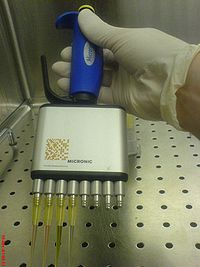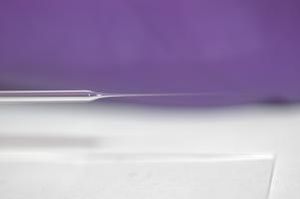- Micropipette
-
A micropipette is one of two different instruments used in science laboratories.
Contents
History
The first micropipette was patented in 1960 by Dr Hanns Schmitz (Marburg/ Germany). The founder of the company Eppendorf, Dr. Heinrich Netheler, inherited the rights and started the commercial production of micropipettes within the sixties. The adjustable micropipette is a Wisconsin invention developed through interactions among several people, primarily inventor Warren Gilson and Henry Lardy, a professor of biochemistry at the University of Wisconsin-Madison.[1]
Adjustable micropipette
Main article: pipettePipettes are used to accurately measure and dispense small volumes of liquid. The capacity of a micropipette can range from less than 1 µl to 1000 µl (1 ml), while macropipettes can measure volumes greater than 1ml.
Micropipettes brands include ErgoOne, Eppendorf, Hamilton, Rainin, Drummond, BrandTech, Oxford, Hirschmann, Biohit, Labnet, Nichiryo, Gilson, Corning, VistaLab, Thermo, Jencons, Vertex, Handypett, and Pricisexx.
Glass micropipette
These are used to physically interact with microscopic samples, such as in the procedures of microinjection and patch clamping. Most micropipettes are made of borosilicate, aluminosilicate or quartz with many types and sizes of glass tubing being available. Each of these compositions has unique properties which will determine suitable applications.
Glass micropipettes are fabricated in a micropipette puller and are typically used in a micromanipulator.
Microfluidic pipette
A recent introduction into the micropipette field integrates the versatility of microfluidics into a positionable pipette platform. These are used to create a recirculation zone, allowing for constant control of a micrometer sized environment at the tip of the pipette. Currently these pipettes are made of polydimethylsiloxane (PDMS) which is molded from a physical master. Interfacing of these pipettes allows for multiple solutions to be loaded and switched on demand, along with concentration control and solution pulsing. Invented by Alar Ainla in Owe Orwar's group[2] at Chalmers University of Technology in Sweden.[3]
Micro Pipette calibration
Micro Pipettes are one of the most important tool for various procedures in a laboratory. The accuracy and precision of pipette decides the quality of test result perform in particular laboratory.
Micro Pipettes assist lab technician in handling liquids with precise measurement. It is a superior edition of medicine dropper or pasteur pipette or serological pipette and works on the equal principle of making equivalent vacuum for drawing up the liquid. With the purpose to make sure correctness at all times, Micro pipette requires to be calibrated. This process is known as pipette calibration.[4]
Irrespective of brand of pipette or how expensive pipette is, every micro pipette manufacturer recommends checking the calibration at least every six months if used regularly. Companies which are involved in with drugs or foods are needed this procedure of calibrating quarterly or in every three months. Schools which are conducting chemistry classes can have this process annually other than those who are involved in the forensics and research where scores of testing goes on so that they have to perform this monthly.
See also
References
Categories:
Wikimedia Foundation. 2010.


